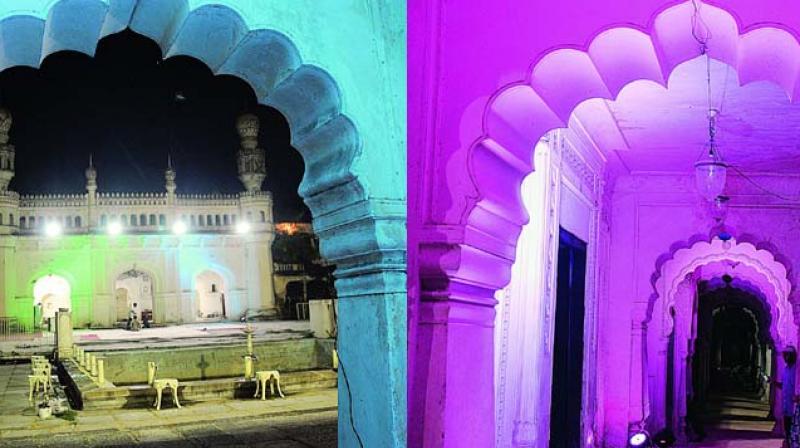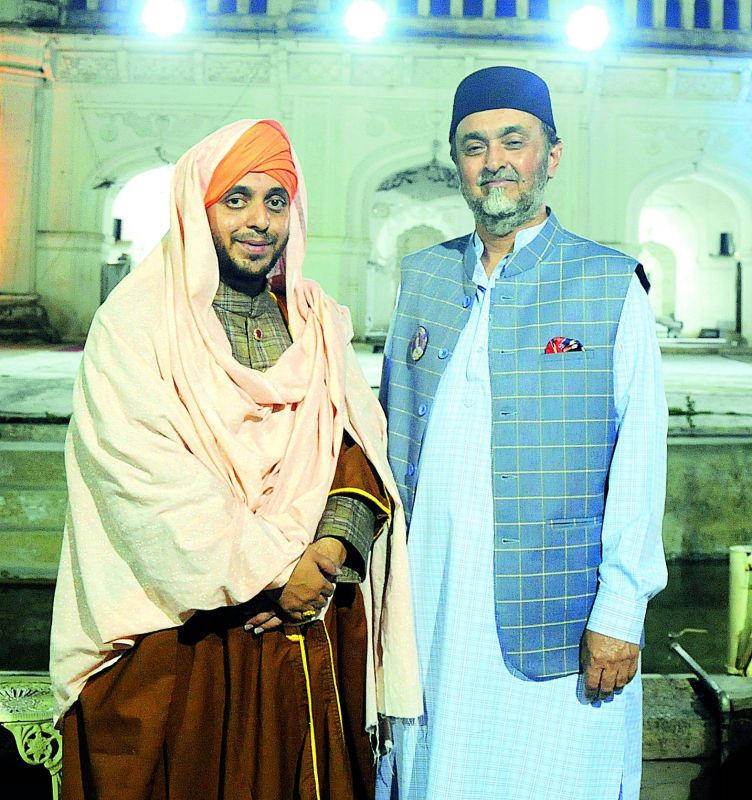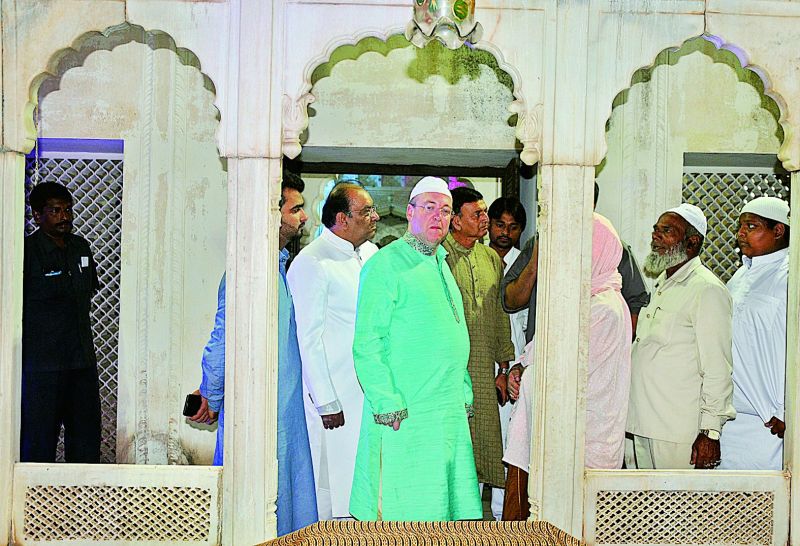Hyderabad: Where nobility meets spirituality
Some writers have traced the lineage of Baba Farid back to the second Caliph.

The urs of Hazrath Baba Fariduddin Ganjshakar was held at the Paigah Tombs, Santoshnagar, Hyderabad, on September 15 and 16 and as per the the Hijri calendar, on the fifth day of Muharram.
Constructed during the 18th, 19th and 20th centuries, the Paigah Tombs is the final resting place for the Paigah family. Located at Phisalbanda, near Santoshnagar, the tombs are made out of lime and mortar with beautiful inlaid marble carvings. And when lit up, the tombs get an ethereal look.
The urs is commemorated on the day Baba Farid left for his heavenly abode in 1266 AD and he was buried outside the town of Pakpattan, now in Pakistan. Baba Faridud-din Ganjshakar was one of the greatest Sufi saints of the subcontinent. While he travelled only in the northern parts of India, his children are said to have settled in the Deccan in Hyderabad state.
Some writers have traced the lineage of Baba Farid back to the second Caliph.
Abul Khair Khan, the son of Sheikh Bahauddin Khan, governor of Shikohabad under Emperor Aurangzeb, was an accomplished young man and was noticed by Emperor Muhammad Shah’s senior minister, Mir Qamaruddin Khan, Nizam-ul-Mulk -- the future Asaf Jah I.
The descendants of Baba Farid soon attached their careers to that of Nizam-ul-Mulk and then married daughters of successive Nizams and consequently, the Paigahs were considered next only to the Nizams in protocol.
Descendants of the Paigahs conduct the urs, (it is more of a commemoration than a celebration) at the Paigah tombs since the actual urs is celebrated at Pakpattan and is attended by thousands of people. The three most famous Paigahs were Sir Vicar-Ul-Umra, Sir Asman Jah and Sir Khurshid Jah and they were the premier nobility of the Hyderabad state.
 Shahid Faridi, a Paigah descendant, with Mohd Sultanuddin Khan.
Shahid Faridi, a Paigah descendant, with Mohd Sultanuddin Khan.
Mohammed Sujahuddin Shahid Faridi, a Paigah descendant and great-great grandson of Sir Khurshid Jah, has taken the saintly route and has been conducting the urs for the last 12 years. “Almost a century ago, there was a Ganj custom. For the Bismillah of a boy, they would wash the hall and spread a white cloth and place red cloth over it. One hundred and quarter kilo of sugar would then be kept there with a red rose on top.
“The room would then be locked. My grandmother has told me that though the room would be locked, the next day it would seem like someone had taken a pinch of sugar, as if someone had tasted it, and there would be imprints of fingers on the sugar. Prayers would then be recited and then a Diya lit.
 British deputy high commissioner in Hyderabad Andrew Fleming during Urs recently.
British deputy high commissioner in Hyderabad Andrew Fleming during Urs recently.
“It was during the time of my grandfather Nawab Muniruddin Khan Bahadur, son of Imam Jung, it was decided that instead of 100 and quarter kg of sugar, there would one and quarter kg of sugar kept for every male child,” Shahid Faridi said.
This custom is connected to Baba Farid and his name which was given to Shahid Faridi by his mother. There are several stories as to why Baba Fariduddin Ganjshakar (Ganj in Persian means ‘treasure’ and ‘shakar’ means ‘sugar’) was known so and the most appealing of them is that when as a boy as Baba Farid was learning prayers from his mother, Bibi Miriam, the boy asked her what was gained by prayer. His mother replied sugar. Accordingly, she used to hide some sugar under his prayer carpet and when he had finished his prayers, give it to him as a reward of his devotion. One day his mother forgot to put the sugar but after his prayers the boy still found sugar under the carpet. From that day on, Bibi Miriam started calling her son Shakar Ganj, or the treasury of sugar. There are several other miracles also credited to this great Sufi saint.
According to Shahid Faridi, Baba Farid had three daughters and five sons. It was with the third son of Baba Farid that the Paigah family began. It was during the reign of the second nizam, Asaf Jah II, that he shifted his capital from Aurangabad to Hyderabad in 1763. Hyderabad became the new capital and later even lent its name to that of the state he created.
It was also during his reign that the Paigah (the household troops) was introduced. Abul Fatah Khan Tegh Jung came from Aurangabad to Deccan and then to Hyderabad. Aurangabad was then the gateway to Deccan. Nawab Abul Fatah Khan Tegh Jung Bahadur Shamshul Umraah was the founder of the Paigah family and was the grandson of Baba Farid.
“Our ancestors were great Sufi saints,” says Shahid Faridi.
“The Paigahs and the Nizams moved in close quarters since all the males in the Paigah family would marry the daughters of the Nizam family.
The bond between the Nizams and the Paigah nobility strengthened with the marriage of Abul Fatah Khan’s son Fakhruddin Khan to the daughter of Mir Nizam Ali Khan, Asaf Jah II, Sahebzadi Bashirunissa Begum, in 1797. Henceforth, Fakhruddin Khan’s descendants married daughters of other Nizams and consequently, the Paigahs were considered next only to the Nizams in protocol.
“Lady Vicar, Nawab Afzal ud Dowlah’s daughter, was married to Sir Vicar Ul Umrah, my great, great grandfather,” says Sultanuddin Khan, the great-great grandson of this great man who built the Falaknuma Palace and then gifted it to the Nizam Mahboob Ali Pasha.
Only one lady from the Paigah family married into the Nizam’s family. She was the daughter of Imam Chand, Sahibzadi Mazhar Unissa Begum Sahiba.
There are many wonderful and inspiring stories about Baba Farid. One of them is that when Garibnawaz Moinuddin Chisti went to meet Baba Farid when he was doing Chilla (praying in seclusion for 40 days reading the Holy Book for 40 days).
When he hugged Farid, and the latter went on to say “what ilm I wanted to gain in my life I could not do it with my readings, but I got it when Moinuddin Chisti hugged me.” This is known as ‘Seena ba seena’ or transfer of knowledge,” says Shahidi, adding “We call it “attai ilm” or as “god’s gift” because the said person is the selected person.”
In fact, Shahid Faridi prayed that he should also be the selected person and as luck would have it, some miracles happened with him. On every urs day, Shahid Faridi goes to the Dargah Shah Khamoosh in Nampally, where the Jannati Darwaza, or the door to heaven, is erected.
“This was originally in Pakpattan 700 years ago, but came to Shah Khamoosh some 200 years ago. The people at Pakpattan had removed it as it was narrow and kept it aside. Then, on a special request, it was brought to Hyderabad and was fixed at the main entrance of the Dargah Shah Khamoosh, since this too was built by the Paigahs. The sandal wood was falling apart and so a silver covering was given to keep it intact.
“In fact, when the door arrived from Pakpattan at the Nampally station and was being brought to Shah Khamoosh, the entire Paigah force followed it with Baba Farid’s zikr,” recollects Shahid.
“Because I am following Baba Fariduddin, I have taken the name of Faridi. A Khilafat Nama, or ‘ruhani ijazzat’, a special letter, has come from Pakistan permitting me and giving me spiritual authority that I can follow up on the spiritual subjects relating to Baba Farid.
“Habib Jung Bahadur was doing the urs earlier, but at his house. I am now conducting the Urs for the last 12 years,” says Shahid Faridi. The Urs is conducted for two days and there is a small exhibition of Tabarrukat (Baba Farid’s belongings), which Shahid has painstakingly collected over a period of time. This includes the Mazhar ka kapda, kouris (which was used instead of cash in those days), sandal and dried flowers.
On that day, Shahid Faridi visited the Dargah Shah Khamoosh along with Akbar Nizamuddin, where the Jannati Darwaza or Bihasti Darwaza was kept open. “We passed through it and prayers were conducted and then I returned to the Paigah tombs. We both continued our programmes in these two places.” But, qawallis are not sung on these days as it being Muharram. “There are no qawallis in the Chistiya khankas for 11 days since no musical instrument is allowed during this period. Only Naath and manqabat are read in honour of the Prophet and in honour of Aulia Allah. We read it without musical instruments. It is a recitation of what the poet has written about the Prophet. It depends on what the poet writes, and could be lengthy or short,” adds Shahid.
“And since this is about Baba Farid Ganj Shakar, we make small packets of sugar and distribute it among the people. We then go to the grave of Tegh Jung Bahadur and present a Chadar e Gul because he is our ancestor,” says Shahid.
It is said that one of Baba Farid’s most important contributions was to Punjabi literature. While Sanskrit, Arabic, Turkish and Persian had historically been considered the languages of the learned and used in religion, Punjabi was generally considered more of a folk language. There were poets who had written in folk Punjabi, but when Baba Farid used Punjabi as the language of poetry, he laid the foundation for vernacular Punjabi literature, according to Wikipedia.
According to one legend, Baba Farid stopped by a city, then named Mokhalpur, and sat in seclusion for 40 days near the fort of King Mokhal. The king was said to be so impressed by his presence that he named the city after Baba Farid, which today is known as Tilla Baba Farid or Faridkot.

